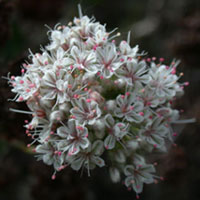***
Upper Newport Bay Project
Why Restore Upper Newport Bay?
Guide to Plants of the Upper Newport Bay
Right Column
Guide to Plants of Upper Newport Bay

--Henry Van Dyke
Welcome to the Plant Page, where you will find an introduction to 25 common plants of Upper Newport Bay. This is a product of a dedicated and talented volunteer, Don Millar, who photographed plants for over three years to capture the blooms and seeds during their season. The pictures and descriptions should help you recognize the plants you will encounter during restoration projects and on outings in this habitat. You can find a larger index of Upper Newport Bay plants by visiting the Newport Bay Conservancy website.
Photos and descriptions of the plants can be accessed in the following ways:
• By Common Name
• By Scientific Name
• By Native or Non-Native Designation
• By Habitat Type
For each plant you will find:
- The common name and the scientific name. The scientific (Latin)
name allows us to share information without inaccuracies (since plants are
typically called by more than one common name). Often, the Latin words can be
translated to descriptors. Longifolius, for example, means long leaves.
Scientific names have two parts and are written in italics. The genus is always
capitalized and refers to a group of species that have similar characteristics,
such as roses. The genus for rose is Rosa. The species name follows
the genus. Species are identified by their ability to successfully reproduce with
one another.
- A description of the phenotype (physical characteristics) along with a
photograph of the plant. The description includes interesting facts such as
origin, edibility, and habitat.
- The size, shape, scent, and color of the leaf and flower. Although flowering
times vary, most of these plants bloom either in spring or year-round.
Often the shape, scent, or color of the flower can tell you something about
its specific pollinator: hummingbirds visit reddish tube-shaped flowers
because of their vision and beak shape; and while bees like it sweet,
beetles are attracted to rancid smells.
Common Name
• Alkali Heath
• Arroyo Willow
• Beach Evening Primrose
• Black Mustard
• Black Sage
• Bladderpod
• Brewer's Saltbush
• Bush Monkey Flower
• California Buckwheat
• California Encelia (also called Bush Sunflower)
• California Sagebrush
• Coast Goldenbush
• Deerweed
• Giant Reed
• Golden Yarrow
• Horseweed
• Iceplant, Sea Fig
• Lemonadeberry
• Lupine
• Marsh Rosemary (also called Sea Lavender)
• Mexican Elderberry
• Mugwort
• Mulefat
• Myoporum (also called Lollypop Tree)
• Pickleweed
• Saltgrass
• Saltwort
• Shoregrass (also called Wiregrass)
• Southern Spikeweed (also called Southern Tarplant)
• White Sage
• Wild Heliotrope
• Woolly Seablight
• Yellow Star Thistle
• Artemisia californica
• Artemisia douglasiana
• Arundo donax
• Atriplex lentiformis ssp. Brewer
• Baccharis salicifolia
• Batis Maritima
• Brassica nigra
• Camissonia cheiranthifolia
• Carpobrotus chilensis
• Centaurea melitensis
• Conyza canadensis
• Distichlis spicata
• Encelia californica
• Eriogonum fasciculatum
• Eriophyllum confertiflorum
• Frankenia salina
• Heliotropium curassavicum
• Hemizonia parryi ssp. australis
• Isocoma menziesii var. vernonioides
• Isomeris arborea
• Limonium californicum
• Lotus scoparius
• Lupinus ssp.
• Mimulus aurantiacus
• Monanthochloe littoralis
• Myoporum laetum
• Rhus integrifolia
• Salicornia virginica
• Salix lasiolepis
• Salvia apiana
• Salvia mellifera
• Sambucus mexicana
• Sueda taxifolia
Native
A native plant has evolved over thousands of years in a particular region. It has
unique adaptations to region-specific geography, climate, and eco-interactions. As a result,
a community of native plants provides habitat for a variety of native wildlife species.
• Alkali Heath
• Arroyo Willow
• Beach Evening Primrose
• Black Sage
• Bladderpod
• Brewer's Saltbush
• Bush Monkey Flower
• California Buckwheat
• California Encelia
• California Sagebrush
• Coast Goldenbush
• Deerweed
• Golden Yarrow
• Horseweed
• Lemonadeberry
• Lupine
• Marsh Rosemary
• Mexican Elderberry
• Mugwort
• Mulefat
• Pickleweed
• Saltgrass
• Saltwort
• Shoregrass
• Southern Spikeweed
• White Sage
• Wild Heliotrope
• Woolly Seablight
Non-Native
Non-native plants have been introduced, both intentionally and unintentionally,
beyond their natural range. Some "invasive" non-natives will invade complex native plant
communities; since they did not evolve with the surrounding community, they may have
no controls to limit their spread. Non-natives make up 47% of the flora at Upper Newport Bay.
• Black Mustard
• Giant Reed
• Iceplant, Sea Fig
• Myoporum (also called Lollypop Tree)
• Yellow Star Thistle
For more information on the Upper Newport Bay Project, contact Matt
Yurko at myurko@coastal.ca.gov.
